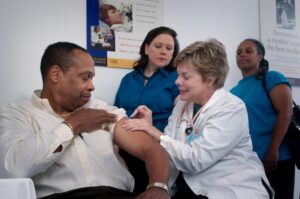
Image c/o Unsplash
Providing care requires the participation of all parties, i.e. patients, families, and a diverse team of highly specialized healthcare and home health care professions.
Involving these teams in a coordinated and cooperative manner is essential in the provision of exceptional care.
Collaborative approaches in care call for interprofessional collaboration in providing team-based patient care as a way to improve patient safety and outcomes.
A partnership between patients, care providers, and families in decision making, cooperation, and coordination is referred to as an interprofessional collaborative practice.
When a patient is receiving care at home, either after hospitalization or home health care, interprofessional collaboration is necessary for the patient’s recovery, treatment, or comfort.
It is, therefore, necessary to understand how interprofessional collaborations can be beneficial in the provision of home health care.
-
Improves Patient Outcomes and Care
Take the case of a patient who has been discharged into the hands of a home care aide or caregiver.
Whether it is a family caregiver or a caregiver from a home care agency, they must work with other teams.
These teams may include physicians, nurses, therapists, nutritionists, pharmacists, and social workers.
By working together, they provide unique perspectives and valuable insights about the patient.
For instance, caregivers can share changes that the patient experiences with the healthcare experts who will, in turn, provide a comprehensive care approach for the patient.
Caregivers should provide accurate information to other teams so that they receive accurate recommendations on how best to provide care.
Accurately sharing information and recommendations improves the patient’s outcomes and makes it easy for the caregiver to provide quality care.
-
Minimizes Readmission and Mortality Rates
Teams working together to provide comprehensive and precise care reduces the chances of a misdiagnosis.
If a patient is diagnosed properly and the caregiver is well informed on the care protocols, they are much less likely to be readmitted for further treatment.
A well-coordinated and collaborative team prevents fatalities for patients receiving care at home.

Image c/o Unsplash
-
Reduces Medical and Care Errors
It has been found that medical errors cause 250,000 deaths annually and are considered the third leading cause of death in the United States.
These deaths are preventable with clinical communication between the caregivers and the other care teams involved.
For medication administration, the caregiver should be lopped in a group conversation with the prescribing physician and pharmacist.
Such communication ensures that the caregiver is aware of the medication’s side effects and expected reactions.
Such information is crucial in treating the patient safely at home while reducing preventable drug reactions, optimizing dosages, and reducing mortality rates.

Image c/o Unsplash
-
Promotes Teamwork and Team Mentality
Interprofessional collaboration in providing care allows team members to support each other while caring for the patient.
It eases the burden of care on caregivers when they are aware that they are not alone in caring for the patient.
Collaboration also prevents caregiver burnout and caregiver guilt which could affect the quality of care being provided.
-
Focuses Primarily on the Patient
Equal contributions by the team ensure the patient is at the core of their unified cause for care.
Even while under the care of a caregiver at home, patients are at ease when they know that there is a team working together to provide effective and lasting care.
-
Reduces Overall Care Costs
Interprofessional collaborations prevent medical errors while delivering better outcomes for the patient. These can significantly reduce healthcare costs.
Patients and their families also save home health care costs.
A reduced recovery time, fewer to no hospital visits or readmissions, or less dependence on a caregiver could help families save on home care costs.

Image c/o Unsplash
-
Closes Down Communication Loopholes
When home care caregivers and healthcare teams work together, they create an environment of open communication.
Environments like these enable them to share ideas and interact on a personal level about the patient’s treatment for quality care.
We recommend that patients receive care at home through a home care agency. All communication is done through an experienced and highly-trained case manager who acts as a medium and leader in the communication loop.
Like and follow us on Facebook, Instagram & Twitter.
Subscribe to our YouTube Channel


